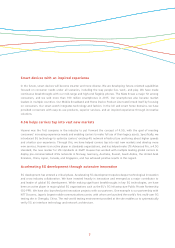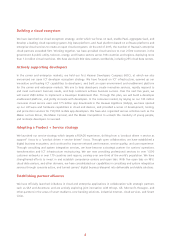Huawei 2015 Annual Report Download - page 19
Download and view the complete annual report
Please find page 19 of the 2015 Huawei annual report below. You can navigate through the pages in the report by either clicking on the pages listed below, or by using the keyword search tool below to find specific information within the annual report.17
Wearables for health & fitness, identification (e.g., for
micro-payments and smart keys), ambient awareness,
and enhanced interaction, will create value like we have
never seen before. Wearables will generate more value
if they are supported by more innovative technologies
in digitization, miniaturization, and natural interaction.
Smart home products are getting connected. Most
smart home products remain isolated from each
other. This has made interconnectivity and information
sharing impossible, and market growth has been
slow. Smart home devices are now being connected
in order to better serve users yearning for products
that are simple, personal, and environmentally friendly.
Digital technology can get devices online, and smart
home platforms can connect devices to each other.
Many vendors are now building smart home platforms
and opening up their communications protocols and
software development kits so that third-party devices
can access them. Vendors are thus building an industry
ecosystem to support smart homes.
Better networks: re-architecting smart
networks
A Better Connected World will require re-architected
telecom networks. It is estimated that, by 2025, the
number of connections worldwide will grow to 100
billion, driven by the demand for full connectivity
of people, things, and businesses. Applications in
vertical industries will need different levels of network
connectivity. For example, smart meters and smart
buildings will require networks with deep indoor
coverage, low power consumption, and minimum cost.
The Internet of Vehicles and smart transportation will
need networks that offer wide coverage, low latency,
and high mobility. Industrial control systems will demand
super high-density connections with ultra-low latency.
Faced with complex demands under diverse network
scenarios, carriers will need new network technologies
and architecture in order to move the industry forward.
That is where 5G comes into play: It will support 100
billion connections, 1 millisecond latency, and speeds
of 10 Gbit/s. SDN/NFV will help carriers establish an
agile, open, and flexible network architecture, and
build management systems that give them a global view
for better management of their networks. With SDN/
NFV, carriers can drive down costs, accelerate service
innovation, and adopt new business models in which
resources are deployed on demand and customers can
purchase exactly the services they need.
The user experience in future networks will be Real-
time, On-demand, All-online, DIY, and Social (ROADS).
To deliver this experience, carriers are modernizing their
networks and services, driving cross-industry and cross-
border consolidation. The scope of the services which
carriers can deliver is being redefined, and the service
portfolio is shifting toward an organic combination
of mobile broadband, fixed broadband, and digital
content.
Better platforms: migrating to elastic
clouds
The cloud platform will be a driver of ICT investment.
In the digital age, many information services can be
offered via cloud platforms, from basic lifestyle services
to enterprise ICT services, from autonomous driving
to AI. Extensive use of cloud services will become the
new normal in enterprise ICT spending plans. With their
capacity to centrally provide services and share massive
data, storage, and computing resources, cloud platforms
will deliver significant gains in service efficiency. And the
larger the user base, the lower the cost, which means
better returns on investment. But clouds will not just
be a form of service provisioning: Cloud platforms can
also support entire business processes, from planning
and design to development. This extended functionality
of cloud platforms will be a further spur to enterprise
ICT investment.
Carriers – with their extensive broadband networks and
ability to deliver local services – can provide enterprise
customers with the hybrid cloud services they need to
stay competitive over the long term. Demand for cloud
data centers will grow rapidly following the widespread
adoption of massive data storage, online analytics, and
cloud services. By 2020, investment in cloud-based
IT infrastructure is expected to exceed non-cloud IT
investment, meaning that cloud will soon be the primary
IT infrastructure market.
























